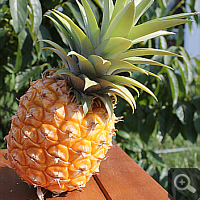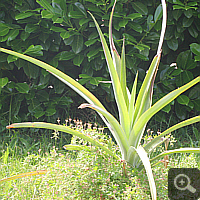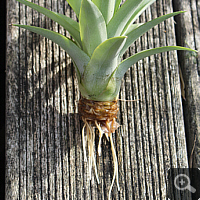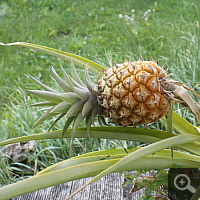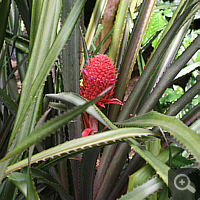Pineapple (Ananas comosus)
Overview
The pineapple is the only member of the bromeliad family (Bromeliaceae) of commercial interest. In contrast to the most other members of the bromeliad family, which grow epiphytic (i.e. on trees as mounting plants), the pineapple grows terrestrial. The original home of the pineapple is America, a wild variety does not exist, so that the today’s cultural pineapple probably should been arisen from Ananas ananassoides.
Description
The pineapple is a perennial plant with a trunk, which is surrounded by leaves spirally. The leaves can reach a width up to seven centimetres and a length of 120 centimetres and are mostly at their ends sharply dentate. In the end the pineapple produces a blossom peduncle with as many as 100 self-sterile single flowers. Also without a successful pollination a fruit is produced.
Culture
As child of the tropics the pineapple demands high temperatures and a rather high humidity. In summer is a culture outdoors possible, at temperatures below 20°C growth is abandoned, for a short time also temperatures just above freezing point are tolerated. Important is an as large as possible pot, because the pinapple produce a distinct root system. The roots are sensitive to waterlogging. Therefore in terms of soil should be paid attention to a loose composition with good water drainage. Optimal pH-value < 5,5. For a successful maturity of fruit constant temperatures above 20°C are required.
After fruiting the pineapple produces numerous sprouts, from which it can be bred vegetatively. But a propagation is also possible from the tuft of a fruit. Use only a tuft which is in good order and condition and whose top is not broken out. separate the tuft transversely from the fruit, then separate all fruit pulp roundabout up to the rigorous stalk in the mid and pluck furthermore all leaves in the inferior third of the tuft. Afterwards turn the tuft on its head and let dry the stalk. Give the tuft the next day within a glass of water, but only so far that the remaining leaves do not come in contact with water. If water should stand in the mid of the tuft, the propagation attempt will fail within a few days because the tuft will rot. Now change regularly water. After circa four weeks up to ten centimetres long roots have developed, so that tuft can be pricked in.
Experiences
Propagation is not difficult, if you abide by the abovementioned method. I have with this one a success rate of circa 80 – 90%. Further culture is not difficult too. Avoid waterlogging, the succulent roots begin quickly to rot. There is a clear correlation between temperature and growth. The pineapple is relative temperature-unsensitive, even longer phases with single-digit degrees above zero are well tolerated. However, a growth occurs only at temperatures of circa 20°C. All in all growth is moderate. By the way, the same statements hold true for the baby pineapple too. In the case of baby pineapples the main difficulty is to find a for propagation suitable tuft, because mostly either the main shoot was broken out from the tuft in the country of origin or the tuft is more or less rotten.
2011
In the meantime my plant has an age of three years. Culture was as yet problem-free, also overwintering. The growth of the pineapple was rather slow.
2013
After it is grown continuously in 2012, it has blossomed this winter. Without a manual pollination it has fruited at last. After seven months, fruit has developed full ripeness in August. In the end the baby-ananas ‚fell victim‘ to a family celebration: After all it was fit for a king.
According to bibliographical references the plant should produce layers during fructification, before mother plant dies off. But so far my plant does not stick by thereon.

